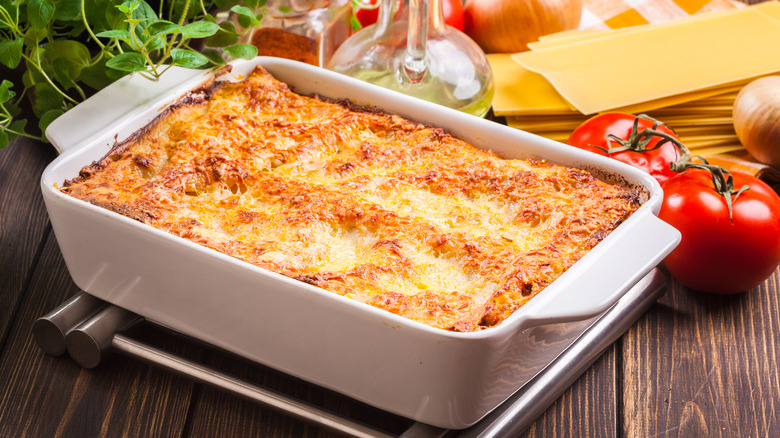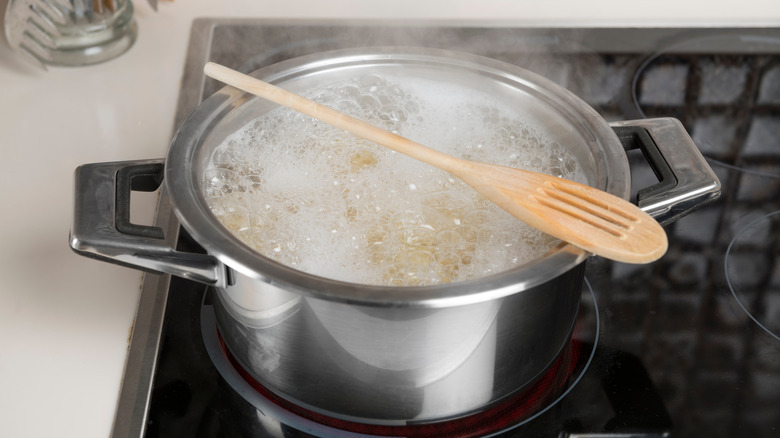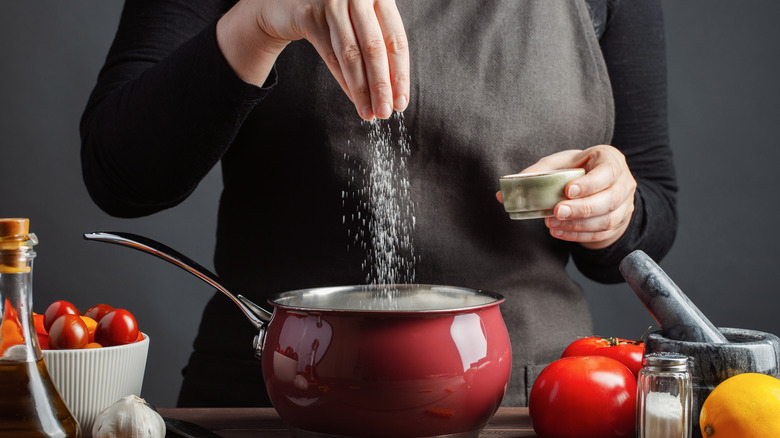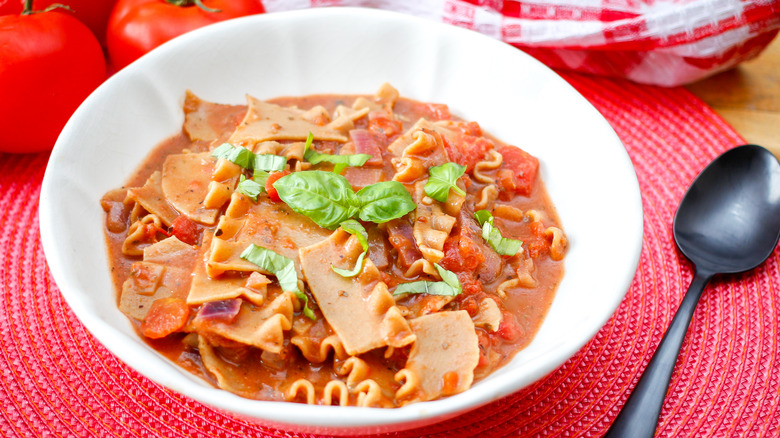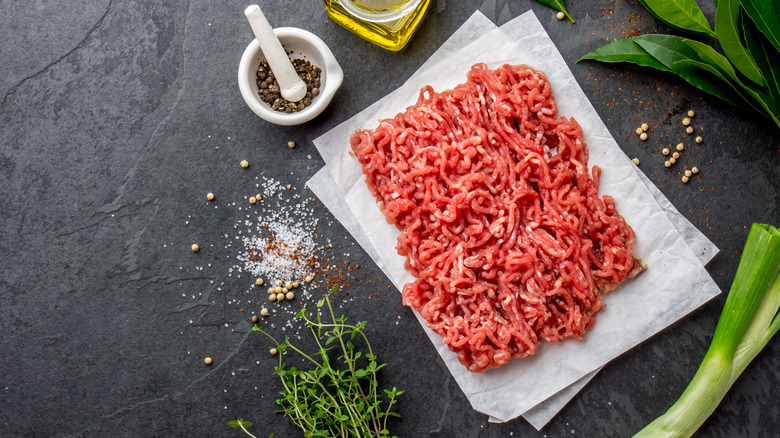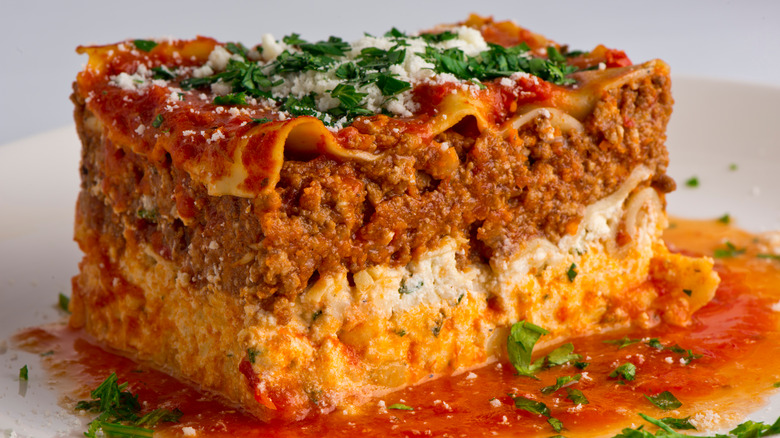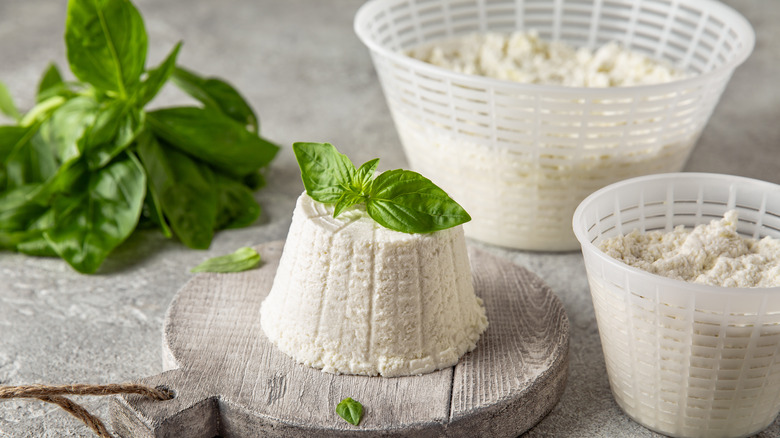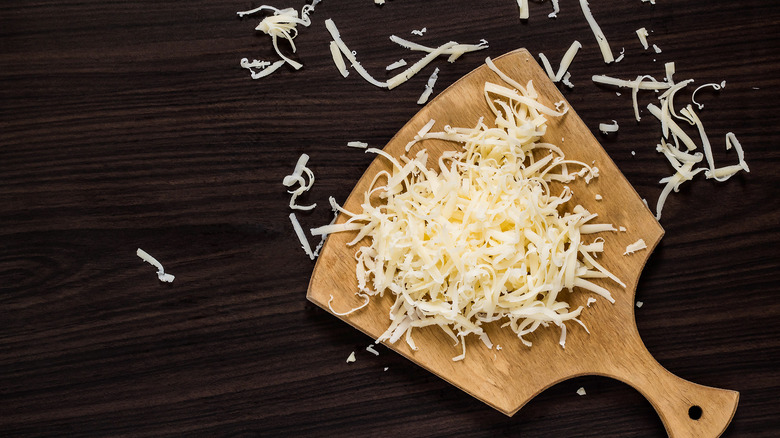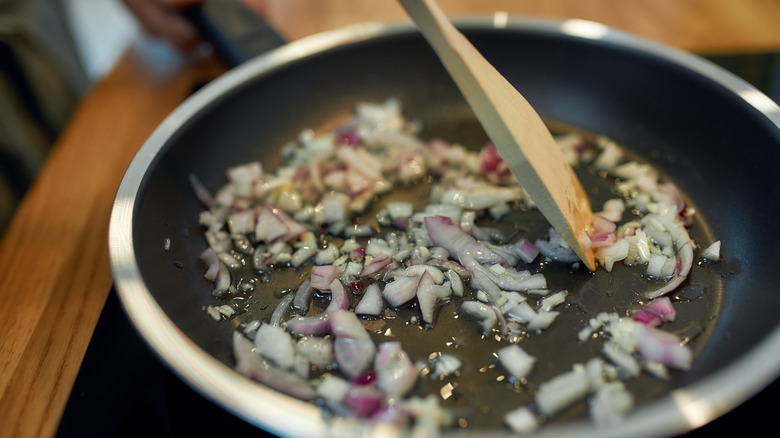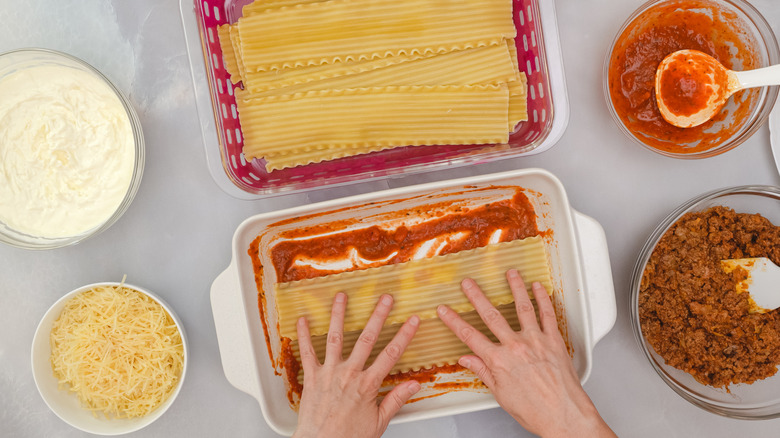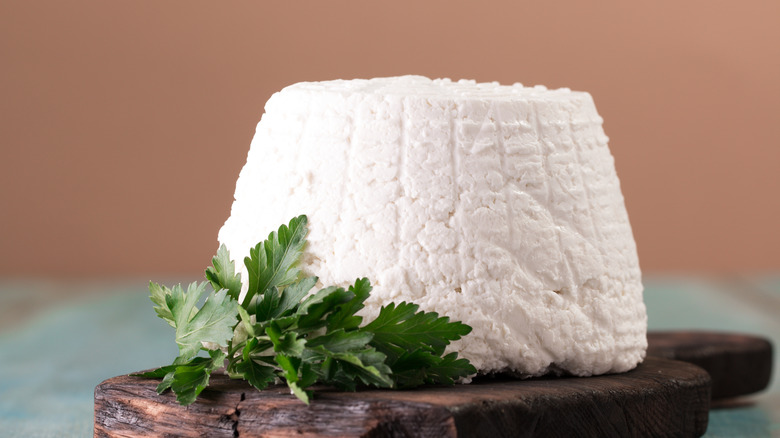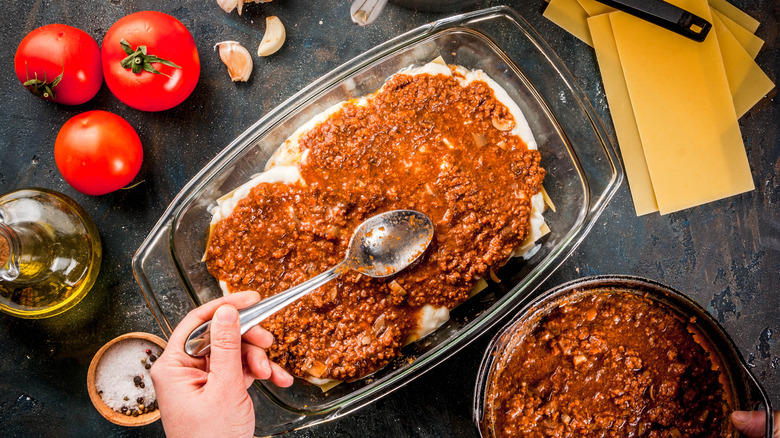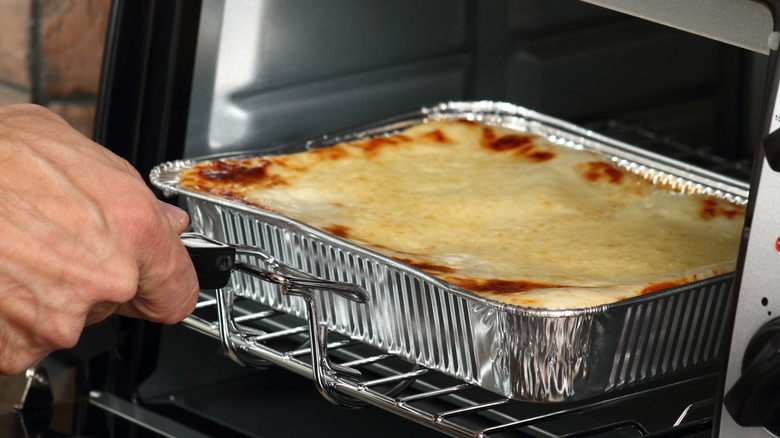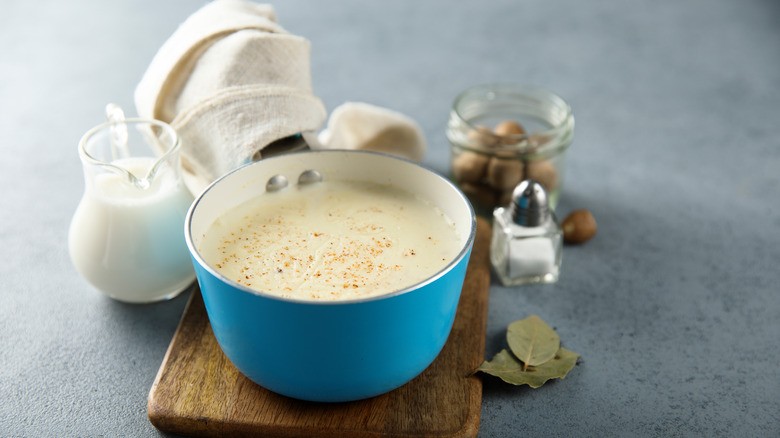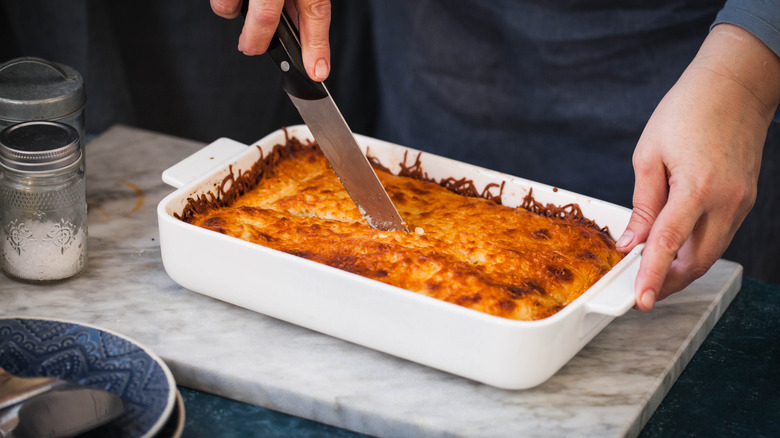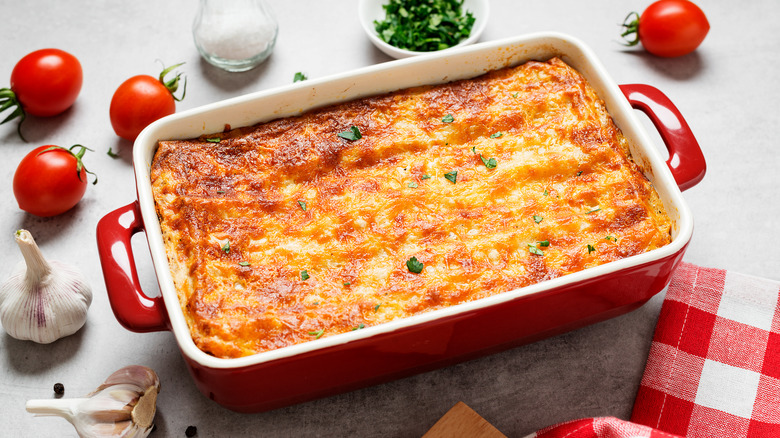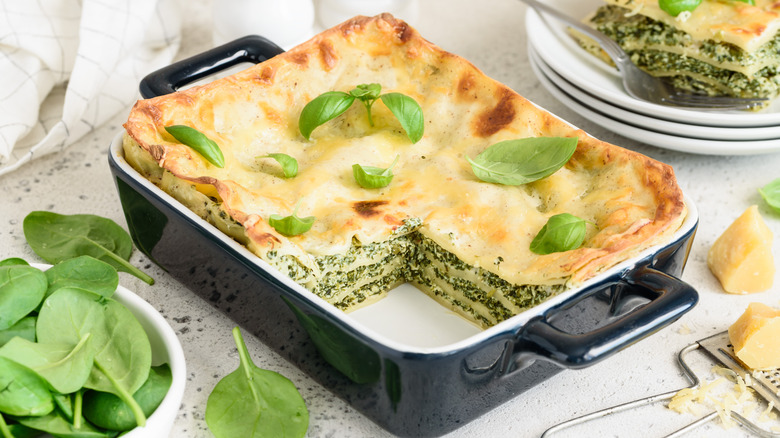16 Mistakes Everyone Makes With Lasagna
Is there any other dish quite as perfect as lasagna? With its layered noodles, gooey cheese, and savory meat soaked in a rich sauce, lasagna is a special kind of comfort food. Sharing a pan of lasagna is a love language and a delicious way to celebrate life's moments. Every home chef knows that lasagna is a crowd-pleaser and the pressure is on to make the best lasagna each and every time.
Learning to make a hearty lasagna is a rite of passage for many home chefs. It's that one recipe that turns you from a novice to a star in the kitchen. Like all skills, it also takes time and practice to get it right. Even the best lasagna straight from nonna's kitchen took time to perfect. Making lasagna is an art form, a delicate dance that requires many steps, from making the sauce to cooking the filling to getting the noodles and layers perfectly aligned. It's a process that is always worth the hours spent in the kitchen.
While there are many types of lasagna, from classic Bolognese to healthier versions with kale, there is no one right way to make it. However, there are some common mistakes that everyone has made. If you are new to making lasagna, you've likely done some of these; it's part of the learning process. In the spirit of learning and lasagna, here are the top mistakes everyone makes with lasagna.
Overcooking the noodles
Let's be honest, it's easy to overcook lasagna noodles, and this is probably the most common mistake when putting together the classic Italian dish. While you don't want mushy noodles, the goal is also to avoid undercooked noodles.
Unlike other kinds of pasta, where you can taste test for texture and color to see if they are done, lasagna is more difficult to check. With lasagna noodles, you want the noodles to be just short of al dente. Al dente in Italian means "to the tooth," and it's when the pasta still has some texture to it. Since lasagna noodles will spend another 45 minutes in the oven soaked in layers of sauce, you want them to be a few minutes shy of al dente so they can finish cooking in the pan.
If testing noodles seems daunting, you can use no-boil (or "oven-ready") noodles instead. No-boil noodles help you avoid this issue because you just layer them into the casserole dish, and they cook right along with the lasagna. There is debate around using no-boil noodles as some consider them to be cheating, and the cooked noodles aren't as firm (via HuffPost). However, they are a time saver that can prevent this common mistake and may be a good option as you perfect lasagna's other elements.
Boiling noodles without oil and salt
The first step to making any pasta dish is to salt the water. Boiling pasta in salt water infuses it with flavor. According to Barilla, you should add salt to pasta after the water comes to a boil but before the pasta goes in.
While everyone acknowledges that salting water is necessary for any pasta, there is a bit of a debate about adding oil as well. Many agree that you should never add oil to pasta water because it's a myth that it will keep it from sticking together. Instead, the oil coats the pasta and keeps the yummy sauce from sticking to it.
However, lasagna noodles aren't just any old pasta, and they follow different rules. According to Lidia's Italy, lasagna noodles are the one pasta that should be boiled with a bit of oil because they're prone to sticking together, making them difficult to separate into layers. So go ahead and splash some olive oil into the water when boiling lasagna noodles; they will be so much easier to work with. Once boiled, strain the noodles, rinse them in cold water, and lay them out flat on parchment paper. They'll be ready to use when it's time to layer the lasagna.
Letting your lasagna get too soupy
You spend hours in the kitchen making lasagna, and it's finally time to cut into it, but you need a large spoon rather than a knife because the lasagna is so soupy. It's a common rookie mistake, and several factors can lead to this result. Being aware of the culprits can help you avoid this watery mess in the future.
The number one reason lasagna turns out soupy is, quite simply, too much sauce. There is such a thing as too much of a good thing, and this is it. To avoid baked lasagna swimming in sauce, use enough sauce to cover each layer but don't go overboard.
Wet ingredients are another reason lasagna turns watery. If you are using ricotta, use cheesecloth to remove any excess moisture. Likewise, when making meat lasagna, make sure to drain out any excess oil that can ruin a good lasagna. Lastly, watch out for moisture-rich vegetables like zucchini and mushrooms that can add too much water to your dish. According to DeLallo, it's best to cook your vegetables before layering them in lasagna.
Using the wrong protein
There are many different ways to make lasagna. Even in Italy, there is no standard approach, though most would agree that a classic lasagna is made with a rich meaty ragù. However, in today's health-focused world, many home chefs are looking for ways to lighten up classically heavy dishes like lasagna. It's tempting to tweak recipes here and there by using ground turkey, chicken, or lean ground beef for a classic lasagna ragù, but this is a mistake. While you may be trying to cut the fat from your diet, an impressive ragù needs the fat.
According to the New York Times, a good ragù requires a mix of pork and beef to keep the desired flavor and texture. Beef alone doesn't have enough fat to flavor the red sauce, and it needs the richness provided by pork. Save the lean meats for other dishes and use a mix of ground beef and pork for your meaty ragù instead.
Overloading the layers
The "bigger is better" approach doesn't work well with lasagna. Sure, a good lasagna has layers, but too many layers in an overstuffed pan is a recipe for disaster. Lasagna typically has three or four layers and keeps a consistent ratio between the noodles, sauce, and filling. Too much sauce results in lasagna soup. If you have too many noodles, it ruins the texture, and too much filling is overkill on flavor. The secret to a good lasagna is a balance of flavors and textures, so each bite gets all of the elements without one dominating.
Keeping lasagna balanced is as simple as following the mantra that less is more and avoiding overstuffed layers. While some restaurants boast 15-layer lasagna, they use fresh, paper-thin noodles that maintain balance despite many layers (via Washington Post). Most home chefs use thicker store-bought noodles, and overstuffing them will ruin a perfectly good lasagna.
Substituting cottage cheese for ricotta
Ricotta is a soft mild cheese common in Italian cuisine. It's used to fill pasta shells, top pizza, stuff calzones, and layer in lasagna, and the mild taste adds the perfect creaminess to a meaty red sauce.
While there are some ways to substitute other soft cheeses for ricotta, you should steer clear of subbing cottage cheese for ricotta in lasagna. While cottage cheese is also a soft, mild-tasting cheese, it has less fat than ricotta (per The Dairy Dish) and lacks the creamy texture and mouthfeel that ricotta brings to the table. If that wasn't enough, the low-fat white cheese doesn't have the structural integrity to be a lasagna layer. It's mushy and will make your lasagna fall apart.
Since ricotta is readily available (and it's easy to make ricotta at home), there really isn't a need to substitute it in lasagna. If you are looking for a vegan alternative, silken tofu will give you creaminess without the dairy (per Tastessence).
Using preshredded cheese
Making a dish of lasagna takes time, from cooking the noodles to browning the filling to assembling the whole shebang. It's only natural that home chefs would want to look for shortcuts like using packaged cheese that's already grated. While this may seem like a good idea from a time management standpoint, it's actually not a great option.
Preshredded cheese has several undesirable extras, such as anticaking agents like potato starch which keep the cheese from clumping (via Science Direct). While these additives prevent preshredded cheese from sticking together, the side effect is that they also make the cheese difficult to melt. And that's not all. According to NPR, a lot of shredded cheese has added fillers, including things like wood pulp. Unless you want a layer of wood pulp and preservatives in your lasagna, it's better to roll up your sleeves and grate your own cheese.
Not precooking filling
Whether making meat or vegetable lasagna, all of the components (except the cheese) should be cooked before assembling and baking lasagna. Essentially, you are just baking the flavors together and melting the cheese.
Ground beef and pork need to be precooked to a temperature of 165 F and ground poultry to 165 F (via FDA). Forgetting or skipping this step could lead to a foodborne illness. While it's unlikely to get sick from eating uncooked vegetables, it is possible (via Eat This, Not That). However, the main reason to precook vegetable fillings is to bring the aromatics together and dry out the vegetables to avoid extra unwanted moisture in the lasagna.
If you are making a summer lasagna with fresh vegetables and prefer the vegetables to keep a bit of their crunch, blanch them instead of sautéing them in oil. Roasting vegetables is another option; ensure they are all relatively the same size so they cook evenly.
Not layering properly
Once the noodles, sauce, and filling are ready, it's time to construct your lasagna, and yes, there is a right way to build the lasagna. First, you should add a bit of olive oil and a splash of sauce to the bottom of the pan (via Today). Remember that the lasagna will be in the oven for around 45 minutes, so having oil and sauce keeps the bottom from burning and sticking to the baking dish.
After you have that base layer, add your first layer of noodles. Cover the noodles with a bit of sauce and a sprinkle of cheese, then add another layer of noodles and your filling. Add a splash of sauce to each layer without drowning it. You can always add more sauce when serving, but it's impossible to remove excess sauce. If you are concerned about the lasagna turning out too dry or if you like extra for dipping, make extra sauce. This is especially nice when serving leftover lasagna; your future lasagna-eating self will thank you for it.
Using unseasoned ricotta
Ricotta cheese has a mild flavor that can translate to sweet and savory dishes making it a versatile kitchen staple. While it is good by itself, it's even better if you season it before adding it to lasagna.
Seasoning ricotta is simple, and you probably already have all the ingredients in your kitchen. Sprinkle in Italian herbs like basil, oregano, and parsley, and add two eggs, yolks, and all. The herbs add a nice flavor, while the eggs give the ricotta more consistency when baked (via The Whole Portion). Soft ricotta cheese is sometimes responsible for a mushy wet lasagna, so adding the eggs is a simple way to keep the layers in place and add another dimension of flavor to your stacked noodles. The eggs also add much-needed saltiness to the ricotta. Whether you're making lasagna or ravioli, seasoning the ricotta filling will take the dish to the next level.
Not using a big enough pan
Does size matter? When it comes to lasagna pans, it sure does. Layers of lasagna noodles soaked in sauce and oozing fillings need to be baked in the right pan. The dish should be large enough to accompany the length of the noodles and deep enough to make at least three layers of lasagna.
While the classic 9-by-13-inch glass baking dish is popular in many kitchens, it might be time to upgrade to a bigger and deeper dish if you make lasagna often or have a big family. After all, you don't want to spend hours preparing your sauce, noodles, and filling only to realize you don't have enough room to fit it all. An overfilled lasagna pan will bubble sauce over the sides and make your oven a gooey mess.
When choosing a baking dish for lasagna, consider more than just size; other factors like material, weight, and cold resistance are also essential (via L.A.Times). In the kitchen, using the right tools is always important, and a good lasagna dish is a good investment.
Baking lasagna uncovered
Baking this dish uncovered results in dry lasagna with a burnt top. Skipping the foil covering is a common mistake that newbie lasagna makers often don't realize until it's too late. It's an easy step to overlook because most of the lasagna parts are already precooked, but it's not quite that simple.
Covering lasagna prevents the top layer from burning while thoroughly heating the middle. Most lasagnas are in the oven for close to 45 minutes, so protecting it keeps the heat in so all of the flavors melt together, and the middle is just as hot as the rest.
The best way to cover the lasagna is to use aluminum foil and loosely cover it so the top layer isn't touching the foil. After all of your hard work putting it together, you don't want to take it out of the oven and have the cheese stick to the foil, so keep the cover loose to protect that top layer.
Leaving out the béchamel sauce
Considered one of the five mother sauces in French cuisine, béchamel sauce is actually an Italian invention (via Los Angeles Times). It is a simple white sauce made with butter, flour, milk, nutmeg, and salt that's commonly used as a base for many French dishes.
For Italians, béchamel sauce is the quintessential dairy ingredient that makes a true lasagna. According to The Washington Post, authentic Italian lasagna is made with béchamel and not ricotta, and it was never considered the main entrée. It was traditionally a lighter side dish with delicate noodles and a light, thin béchamel sauce. Once lasagna landed in the U.S., it morphed into an Americanized lasagna and became popularized as a main dish that evolved into a heavier meal with hearty ingredients.
Home chefs on their way to mastering lasagna should make an authentic lasagna with béchamel. Experiencing the original dish will help you understand the complexity of lasagna and how culture influences foods.
Forgetting to let the lasagna rest
Everybody needs to rest sometimes, and lasagna is no exception. All the gooey components of a cooked lasagna have been bubbling away in the oven, and when they come out, they are not ready to be cut.
If you try and cut lasagna right away, you will end up with a hot mess. Why spend all the time carefully preparing the ingredients and layering your noodles just right if you are going to end up with a plate full of lasagna soup? For a perfectly layered lasagna, sit back and relax and let the ingredients firm up after you take it out of the oven. According to DeLallo, you should let your freshly cooked lasagna rest for 20 to 40 minutes. Lidia's Italy goes a bit further and suggests letting the lasagna rest for two or three hours before cutting and warming each slice.
Not making it the day before
Making lasagna is not for the faint of heart. It takes hours in a hot kitchen, busily slicing, stirring, and assembling. But here is a secret many home chefs don't know: You can make lasagna the day before you plan to serve it. The key is to make it but not actually bake it. Just cover the pan and store it in the refrigerator.
You can also freeze uncooked lasagna for up to a month. You will need to ensure it's in a freezer-safe dish, cover it with foil, and clear a spot in your freezer (a lasagna pan needs plenty of room). When ready to bake it, remove the pan from the freezer about 30 minutes before baking it. You never want to put a dish straight from the freezer to the oven as it can cause thermal shock (via Consumer Reports). Instead, leave it on the counter, let it warm to room temperature, and then bake it.
Sticking to the classic recipe
The last mistake everyone makes with lasagna is not branching out and trying new versions. Of course, you want to perfect your favorite recipe, but then try a variation on this classic Italian dish. Cooking should be fun and fearless. Getting creative in the kitchen is part of the process and why many consider cooking an art form.
Step out of your comfort zone and try Buffalo chicken lasagna or spaghetti squash lasagna boats. You can also create your own version of lasagna with your family's favorite ingredients. Think outside the box and go wild; look to your garden or local farmers market for seasonal inspiration to make something like kale lasagna. Or, take lasagna from a hearty main dish to a decadent dessert with a layered cookie lasagna. Everyone loves lasagna, so master the basics, then make all of the lasagnas you can find.
